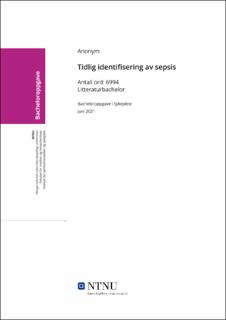| dc.contributor.advisor | Saga, Susan | |
| dc.contributor.author | Roland, Malin | |
| dc.date.accessioned | 2021-09-25T16:25:29Z | |
| dc.date.available | 2021-09-25T16:25:29Z | |
| dc.date.issued | 2021 | |
| dc.identifier | no.ntnu:inspera:81643445:34477999 | |
| dc.identifier.uri | https://hdl.handle.net/11250/2782975 | |
| dc.description.abstract | Bakgrunn: Sepsis er unektelig en alvorlig helsetrussel globalt. Det er avgjørende at sykepleier identifiserer tegn til sepsis i et tidlig stadium, slik at tilstanden ikke utvikler seg til alvorlig sepsis og septisk sjokk. Forskjellige kartleggingsverktøy er utviklet for å tidlig identifisere tegn/symptomer og økt kunnskap om sepsis er essensielt for observasjoner og oppdagelse av sepsis i akuttmottak.
Hensikt: Hensikten med denne litteraturstudien er å belyse viktigheten av å identifisere tidlige tegn på sepsis i akuttmottak slik at tilstanden ikke utvikler seg til alvorlig sepsis, septisk sjokk eller i verste fall død.
Problemstilling: Hvordan kan sykepleier bidra til tidlig identifisering av sepsis hos pasienter i akuttmottak?
Metode: Oppgaven har litteraturstudie som metode som innebærer å utarbeide en problemstilling, systematisk søke etter forskning, kritisk vurdere og analysere forskningen og deretter diskutere resultatet.
Resultater: Funnene fra forskningsartiklene viser til at bruken av screeningverktøy sammen med undervisning bidrar til tidligere oppdagelse av sepsis i akuttmottak. Resultatene viser også til flere barrierer for tidlig oppdagelse av sepsis.
Konklusjon: Gode kliniske observasjoner, økt kunnskap om patofysiologien og bruk av kartleggingsverktøy kan bidra til å oppdage sepsis på et tidlig stadium hos pasienter på akuttmottak.
Nøkkelord: Sykepleie, sepsis, kunnskap, barrierer, tidlig identifikasjon og kartleggingsverktøy. | |
| dc.description.abstract | Background: Sepsis is undeniably a serious health threat globally. It is crucial that the nurse identifies signs of sepsis at an early stage so that the condition does not develop into severe sepsis and septic shock. Various screening tools have been developed to identify signs/symptoms at an early stage and increased knowledge of sepsis is essential for observations and detection of sepsis in the emergency department.
Purpose: The purpose of this literature study is to shed light on the importance of identifying early signs of sepsis in the emergency department so that the condition does not develop into severe sepsis, septic shock or, in the worst case, death.
Problem: How can a nurse contribute to early identification of sepsis in patients in the emergency department?
Method: The thesis has a literature study as a method that involves preparing a problem statement, systematically searching for research, critically evaluating and analyzing the research and then discussing the result.
Results: The findings from the research articles indicate that the use of screening tools together with instruction contributes to earlier detection of sepsis in the emergency department. The results also point to several barriers of early detection of sepsis.
Conclusion: Good clinical observations, increased knowledge of the pathophysiology and use of screening tools can help to detect sepsis at an early stage in patients in the emergency department.
Keywords: Nursing, sepsis, knowledge, barriers, early identification and screening tools. | |
| dc.language | nob | |
| dc.publisher | NTNU | |
| dc.title | Tidlig identifisering av sepsis | |
| dc.type | Bachelor thesis | |
